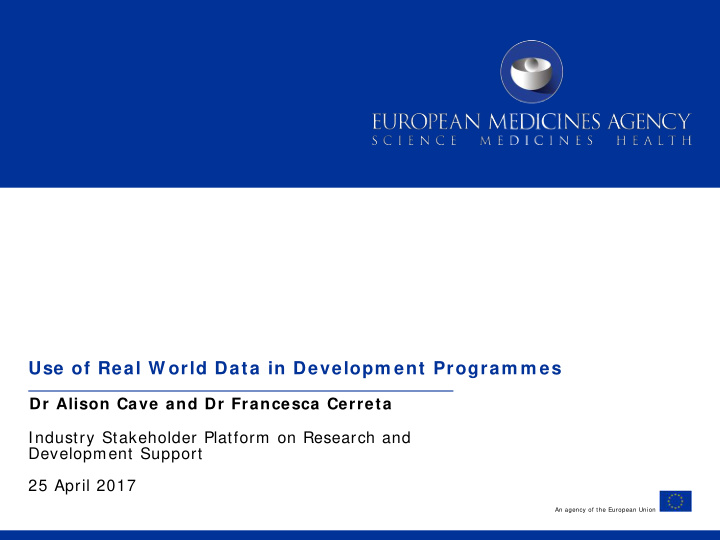



Use of Real W orld Data in Developm ent Program m es Dr Alison Cave and Dr Francesca Cerreta Industry Stakeholder Platform on Research and Development Support 25 April 2017 An agency of the European Union
Objectives 1 2 3 Opportunities Exam ples Conclusions Conclusions 1
Objectives 1 Opportunities Conclusions 2
Opportunities of Real W orld Data Post - Developm ent Authorisation authorisation 3
Opportunities of Real W orld Data Phase 2 Phase 3 Authorisation • Characterisation of natural history of the disease and unm et need • Understanding current clinical care practices ( resource utilisation) • Drug utilisation • I dentification of the target population • Understanding potential know ledge gaps • Validation of surrogate endpoints • Use of historical controls ( rare / orphan diseases) 4
Opportunities of Real W orld Data W hat are the factors affecting acceptability? Product life stage and the question Orphan Lack of treatm ent I s a RCT is condition options feasible? Natural history of the Defined patient Disease context disease is w ell understood population Are datasources Understanding of available, of high Actionable bias and quality and endpoints confounders sustainable? 5
RCT Registries EHRs Claim s data 6
Objectives 1 2 Opportunities Exam ples Conclusions Conclusions 7
Observational evidence in pre authorisation Experience from Scientific Advice/ Adaptive pathw ays An opportunity to reduce uncertainty • Capture real clinical practice, adherence, compliance • Prospective natural history is particularly appealing • Capture rare, long-term events (safety and/ or efficacy) Less costly– important for degenerative and chronic diseases, gene therapy • All subjects could be followed for long term outcomes e.g. ecolizumab • Personalised medicine: capture more strata/ age groups than RCT. Useful to validate biomarkers. Not all endpoints are suitable Consider effort vs. need 8
Registries to supplem ent RCTs: an AP oncology scenario Benefit/ Risk Tim eline of balance in RCT Uncertainties Vehicle to MA route at I A in-m arket interim analysis at MAA address RW D ( I A) In-market safety surveillance (per RMP Com pelling Full MAA at I A PhV reporting any marketed (+ registry?) product) Global X months of Efficacy Safety database registry: data dem onstrated, not adequate or Early Access CMA at I A collection to additional additional safety Program with convert to concerns protocol and safety required full MAA database Global Y months of registry: Prom ising data Additional OS In-market efficacy, safety CMA at I A collection to data collection of convert to data acceptable RWD within full MAA registry Aw ait final Global I nconclusive Unknown TBD analysis registry (?)
Zalm oxis ( 2 0 1 6 ) adjunctive treatm ent in hem atopoietic cell transplantation MAA: single arm, phase I/ II study; Endpoint: immune reconstitution defined as CD3+ cells > 100 per μ L + A Ph III trial ongoing CHMP asked to perform a comparison of the treated patients (from both studies) with results from suitable historical controls EBMT registry used to compile an appropriate control group selected on same criteria as the control arm of the ongoing phase III trial and a specific set of matching parameters: • patient age (plus or minus 3 years) • diagnosis (AML, ALL and sAML) • disease status at HSCT (CR1, CR2, CR3 or relapse) • time from diagnosis to HSCT (plus or minus 3 months) The planned ratio of MM-TK patients to control patients was one to four. Several sensitivity analysis were conducted Post-authorisation: a non-interventional safety and efficacy study will investigate effectiveness in real clinical practice by collecting data about the disease status and outcome of all patients treated with Zalmoxis using the EBMT registry
Objectives 1 2 3 Opportunities Exam ples Conclusions Conclusions 11
Conclusions: Learnings on regulatory acceptability of RW E in product developm ent Generally more acceptable for: o If an RCT is not feasible (time, ethics, rarity) o Hard endpoints (to offset bias) o Conditions with known and predictable progression (note: prospective natural history) o Well thought proposals and trust in their reliability and feasibility 12
Thank you European Medicines Agency 30 Churchill Place London E14 5EU w w w .em a.europa.eu info@em a.europa.eu # AdaptivePathw ays
Recommend
More recommend